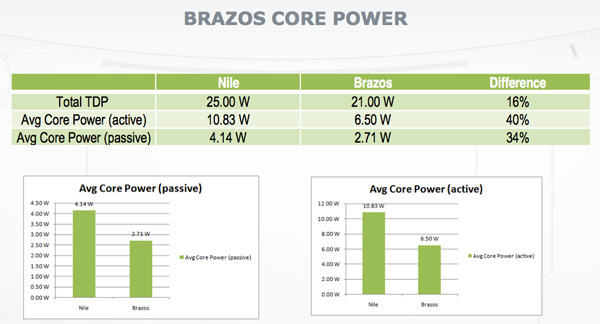The Brazos Performance Preview: AMD E-350 Benchmarked
by Anand Lal Shimpi on November 16, 2010 12:01 AM ESTSetting Performance Expectations
AMD provided this slide of PCMark Vantage and 3DMark Vantage performance of Brazos compared to its existing mobile platforms (Danube and Nile):
If you look at the PCMark Vantage numbers you'll see that AMD's E-350 provides roughly the same performance as an Athlon V120. That's a single core, 45nm chip running at 2.2GHz with a 512KB L2 cache. Or compared to a dual core processor, it's within striking distance of the Athlon Neo K325 which features two cores running at 1.3GHz and 1MB L2 per core. The GPU performance however tells a very important story. While AMD's previous platforms offered a great deal of CPU performance and an arguably imbalanced amount of GPU performance, Brazos almost does the opposite. You get a slower CPU than most existing mainstream platforms, but a much better GPU.
In the sub-$500 market, you're not going to get much in the way of a discrete GPU. What AMD is hoping for is that you'll be happy enough with Brazos' CPU performance and be sold on its GPU performance and total power consumption. From AMD's standpoint, there's not much expense involved in producing a Zacate/Ontario APU, making Brazos a nice way of capitalizing on mainstream platforms. The 75mm2 die itself is smaller than most discrete GPUs as well as anything Intel is selling into these market segments.

AMD's Zacate APU, 19mm x 19mm package, 413 balls, 75mm^2 die
The Comparison
Brazos, like Atom, will fight a two front war. On the one hand you have the price comparison. The E-350 will be found in notebooks in the $400 - $500 range according to AMD. That puts it up against mainstream notebooks with 2.2GHz Intel Pentium DC and 2.26GHz Core i3-350M processors. Against these platforms, Brazos won't stand a chance as far as CPU performance goes but it should do very well in GPU bound games. I've included results from a 2.2GHz Pentium dual-core part (1MB L2 cache) as well as a simulated Core i3-350M in the mobile IGP comparison.
The other front is, of course, the ultraportable space. Here you'll see the E-350 go head to head with dual-core Atom, Core 2 ULV and Arrandale ULV parts. AMD's CPU performance should be much more competitive here. From this camp we've got the Atom D510 (close enough to the N550) and a simulated Core i3-330UM. The expectations here are better CPU performance than Atom, but lower than Arrandale ULV. GPU performance should easily trump both.












207 Comments
View All Comments
mino - Tuesday, November 16, 2010 - link
Troll spoken. Beware.redisnidma - Tuesday, November 16, 2010 - link
After reading this preview, I am starting to believe the rumors floating around in the web about Anand's bias to intel. Shame on him if it's true.Anand Lal Shimpi - Tuesday, November 16, 2010 - link
I don't believe that's true :) Is there anything in the article that you believe incorrectly stated the performance of the E-350 vs. its price (2.2GHz Pentium DC/i3-350) and power competitors (Atom)?Take care,
Anand
mino - Tuesday, November 16, 2010 - link
Problem is not the numbers themselves.It is the focus of the article to workstation/gaming market along with an unfortunate selection of benchmarks.
For the uninitiated without a gift of reading between the lines, the whole article comes out saying "Oh, another over-hyped CPU crap from AMD barely matching a 2yrs old Intel Atom. Lets move on to discuss some important SB rumors".
khimera2000 - Tuesday, November 16, 2010 - link
I am starting to get that feeling to unfortionately. Ive read this sight for a long time although i only this year started posting it does look like the language used is getting more and more lop sided, Although i still enjoy reading the sight im just not getting what I use to get out of there reviews.Then again I can be byast because of the AMD 6xxx reviews... which did feel vary vary bias, and was blasted not for the reviewing and conclusion but the choice of componants for testing. at least thats how i see it.
Dark_Archonis - Tuesday, November 16, 2010 - link
Are you serious? The gaming market was compared because well, you know, AMD HYPED Bobcat for gaming!This is ridiculous. AMD hyped gaming performance and GPU performance for Brazos, and therefore gaming benchmarks are perfectly applicable in this situation.
If AMD talks the talk, they need to walk the walk. AMD should have never hyped the GPU performance or gaming performance of Brazos in the first place, given that Brazos struggles in a variety of gaming situations.
mino - Tuesday, November 16, 2010 - link
No, AMD did not "HYPE" Bobcat for gaming.It said that Zacate is a game changer that provides discrete-class performance to the APU market.
That market is currently represented by a really mediocre Atom APU's that can not even launch the games, not to mention playing them.
It actually went out of its way NOT to hype Ontario by excluding it from its Fusion branding.
Dark_Archonis - Tuesday, November 16, 2010 - link
Zacate is not a game-changer, because it does NOT provide "discrete class" GPU performance.Bobcat was hyped through the hyping of Zacate.
silverblue - Wednesday, November 17, 2010 - link
But it obviously DOES provide discrete-class GPU performance. Low end, yes, but it still fulfills its purpose. And for far less power than the low-end discrete cards will use.Dark_Archonis - Tuesday, November 16, 2010 - link
I am starting to believe the rumors of more and more AMD PR people infiltrating tech websites are true ...